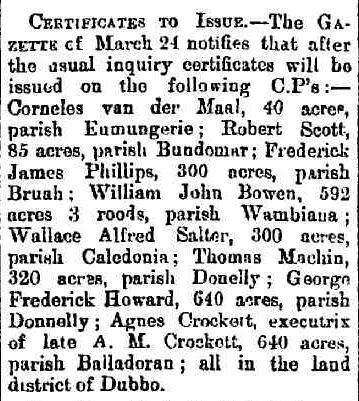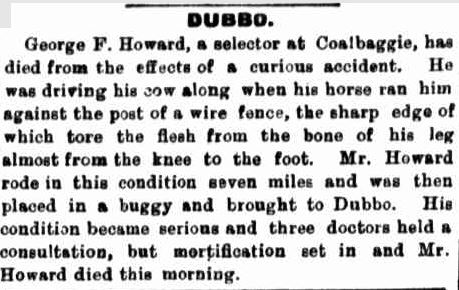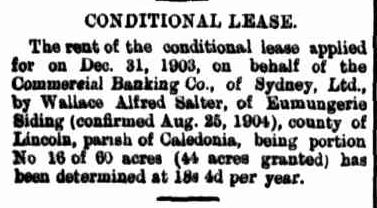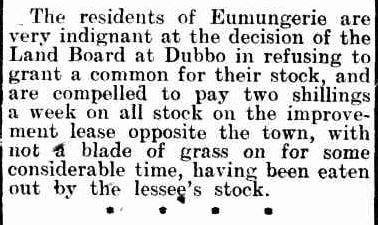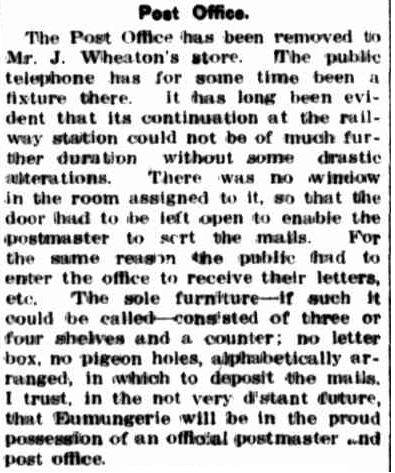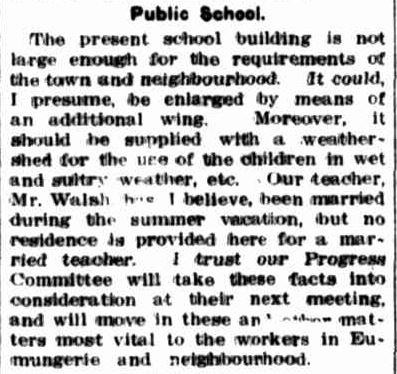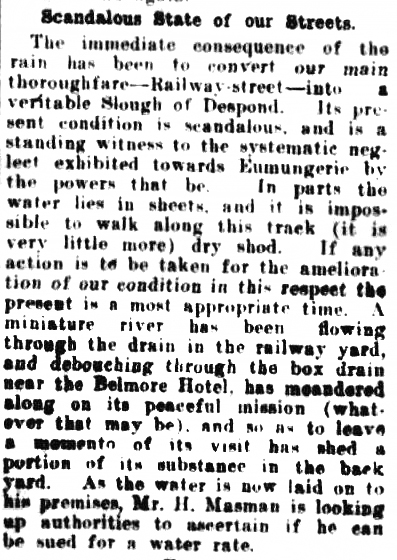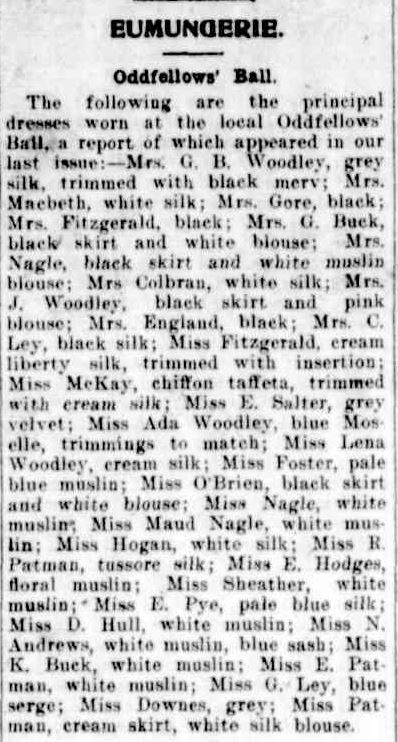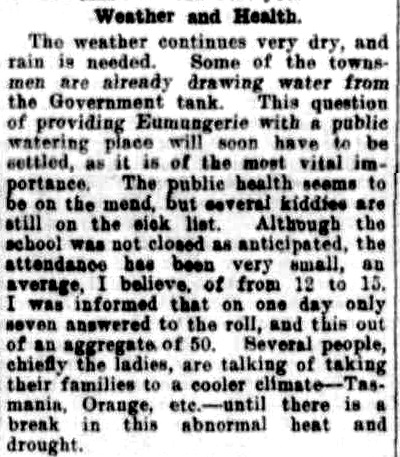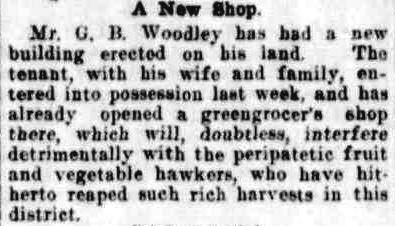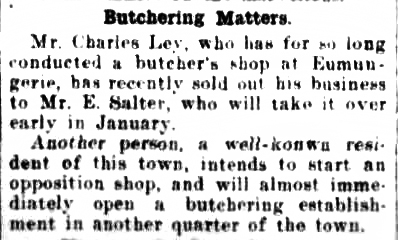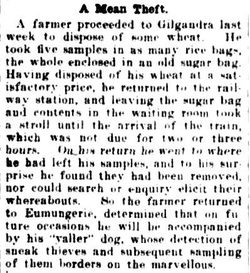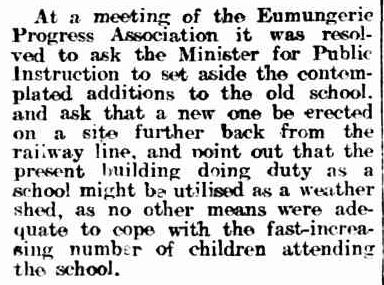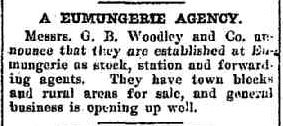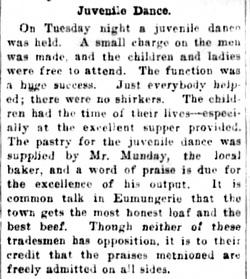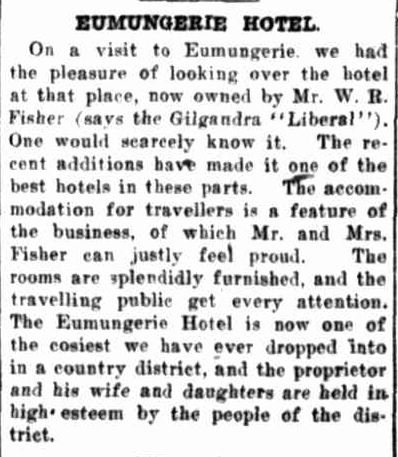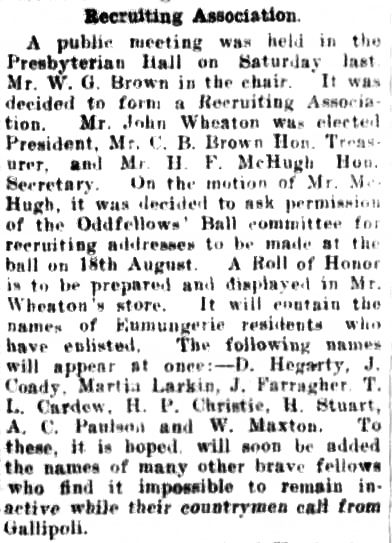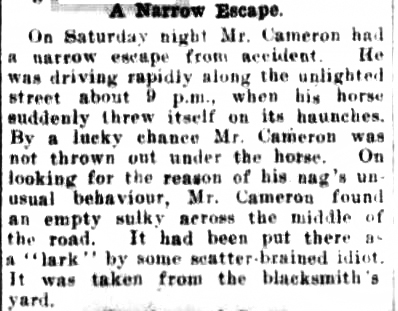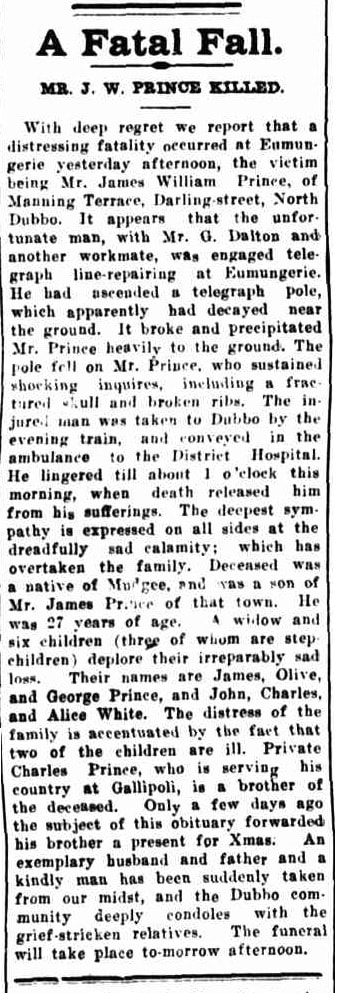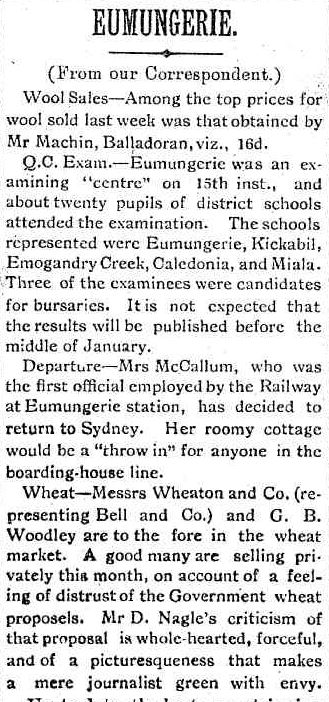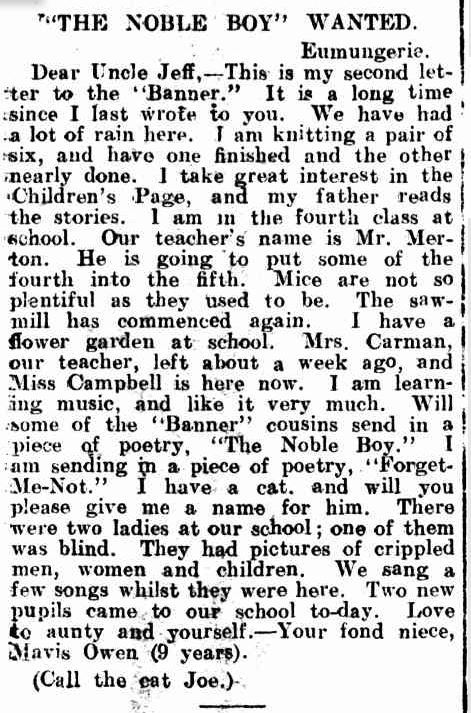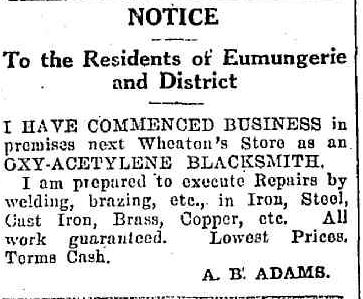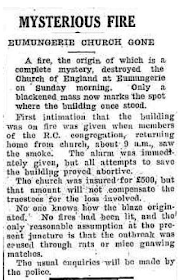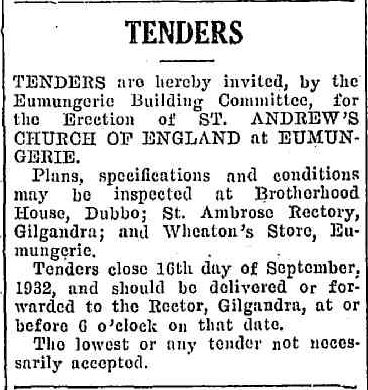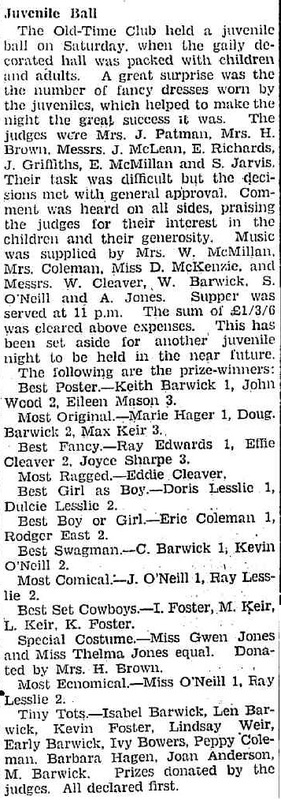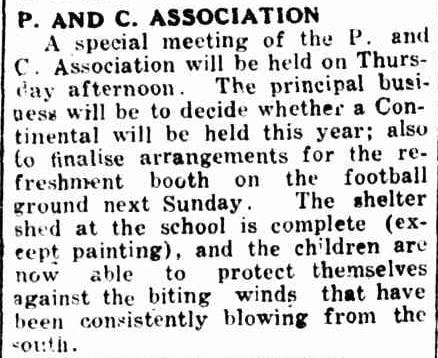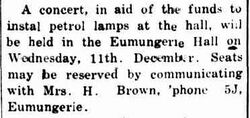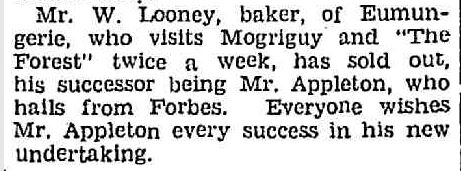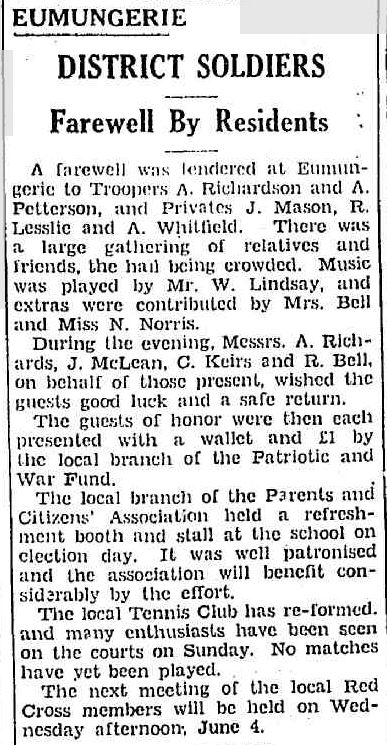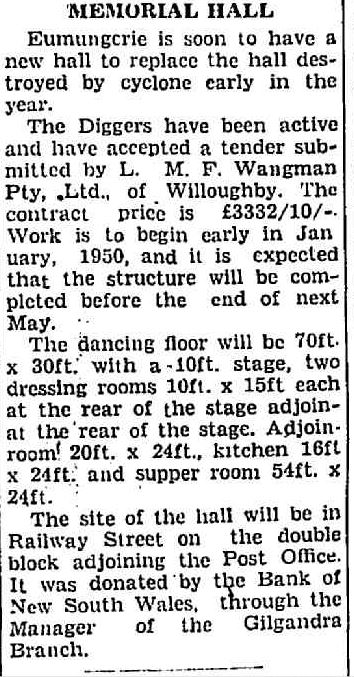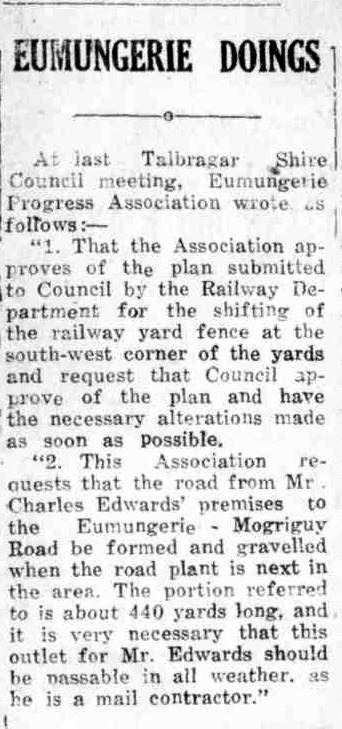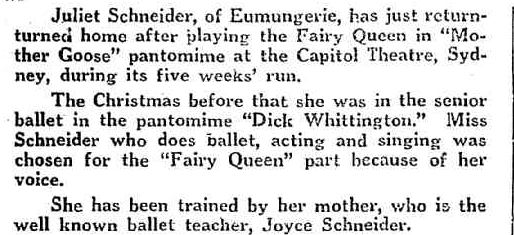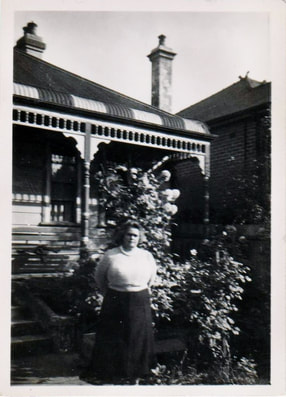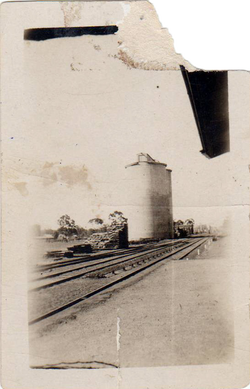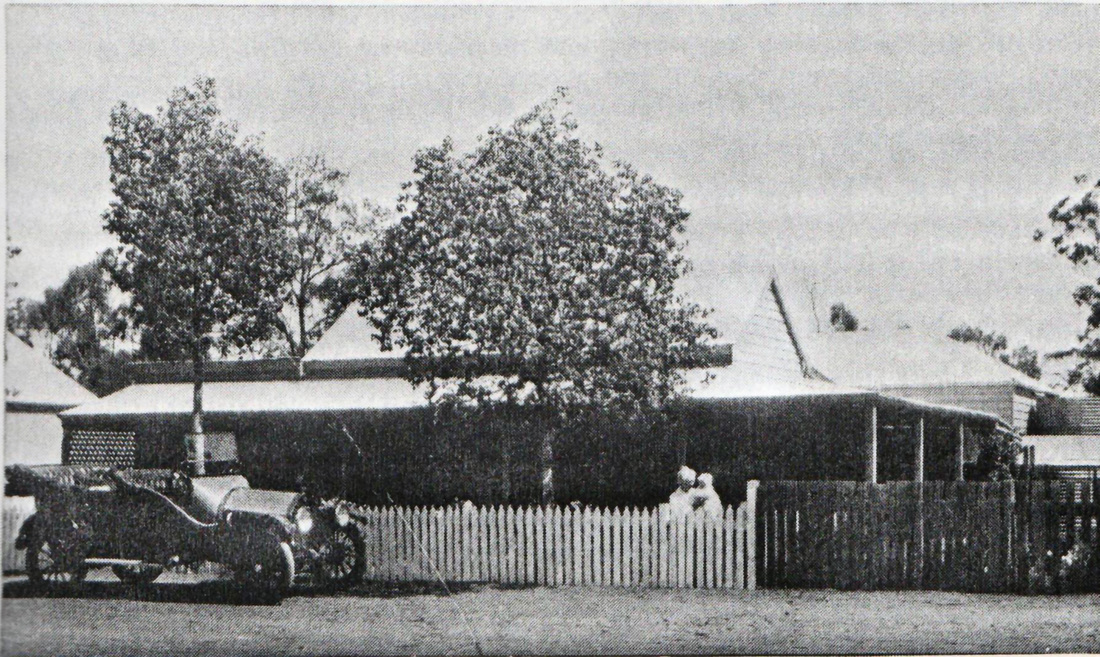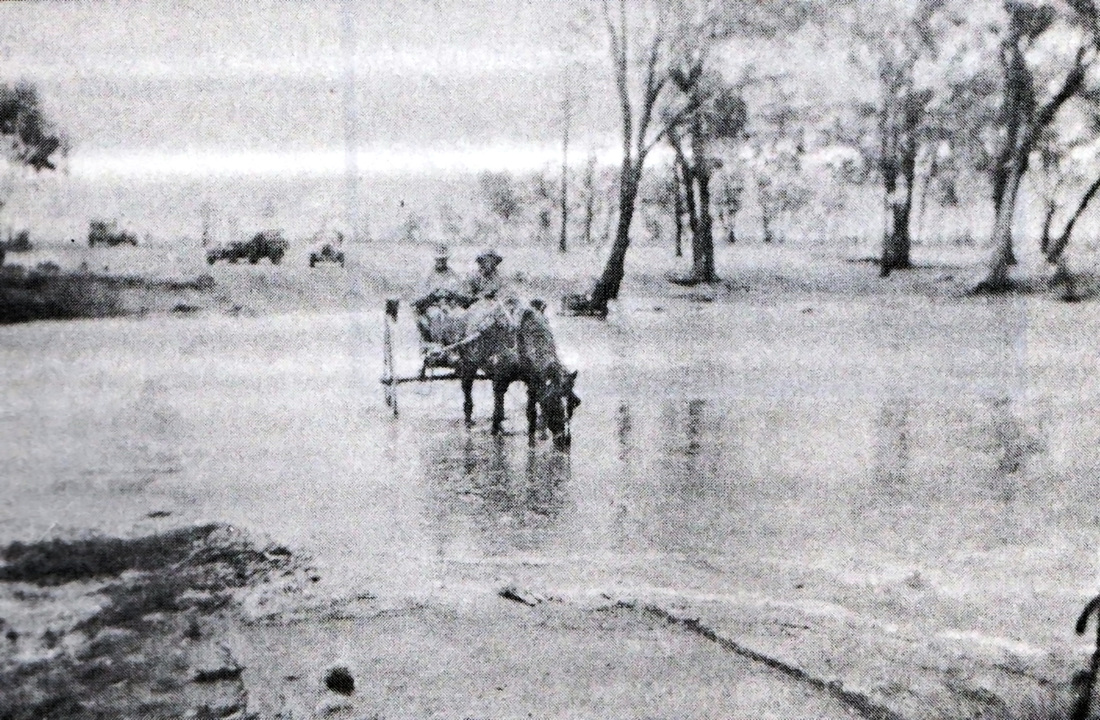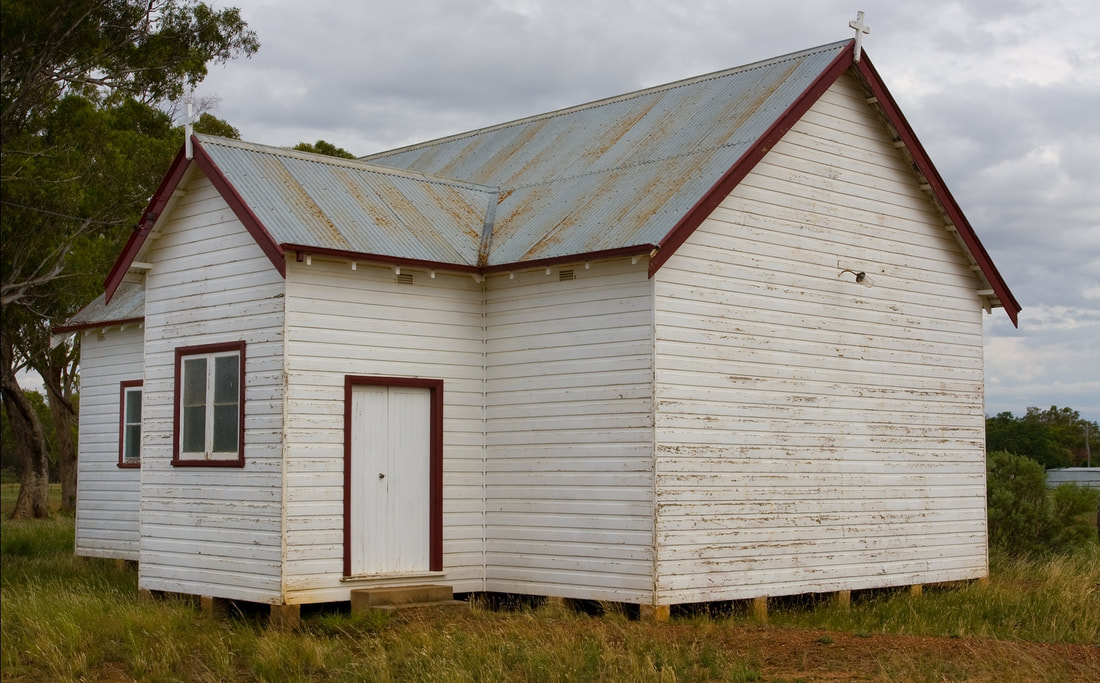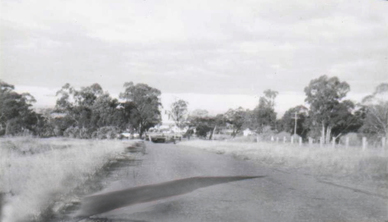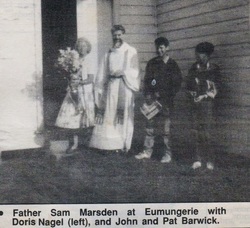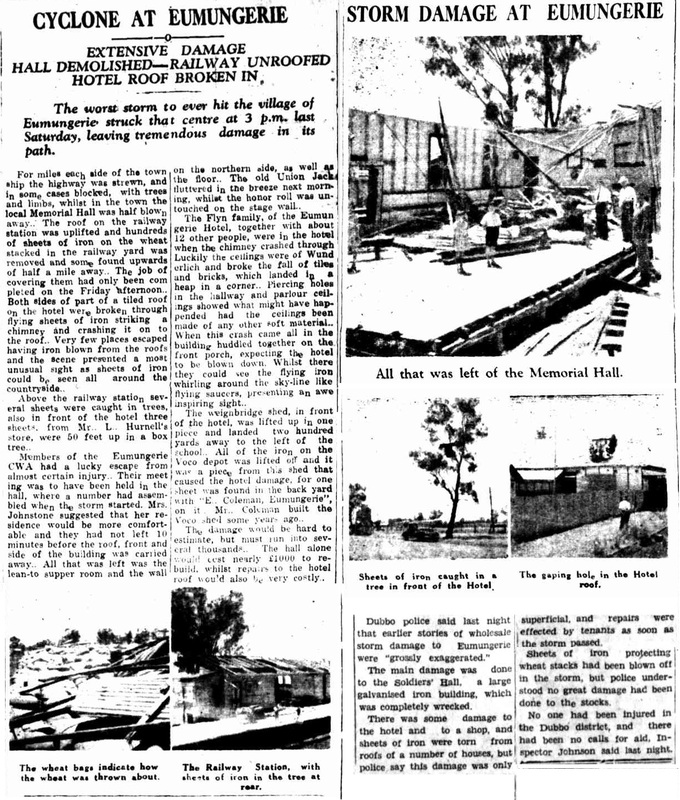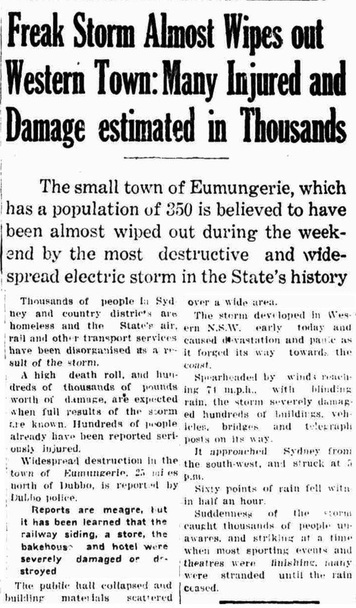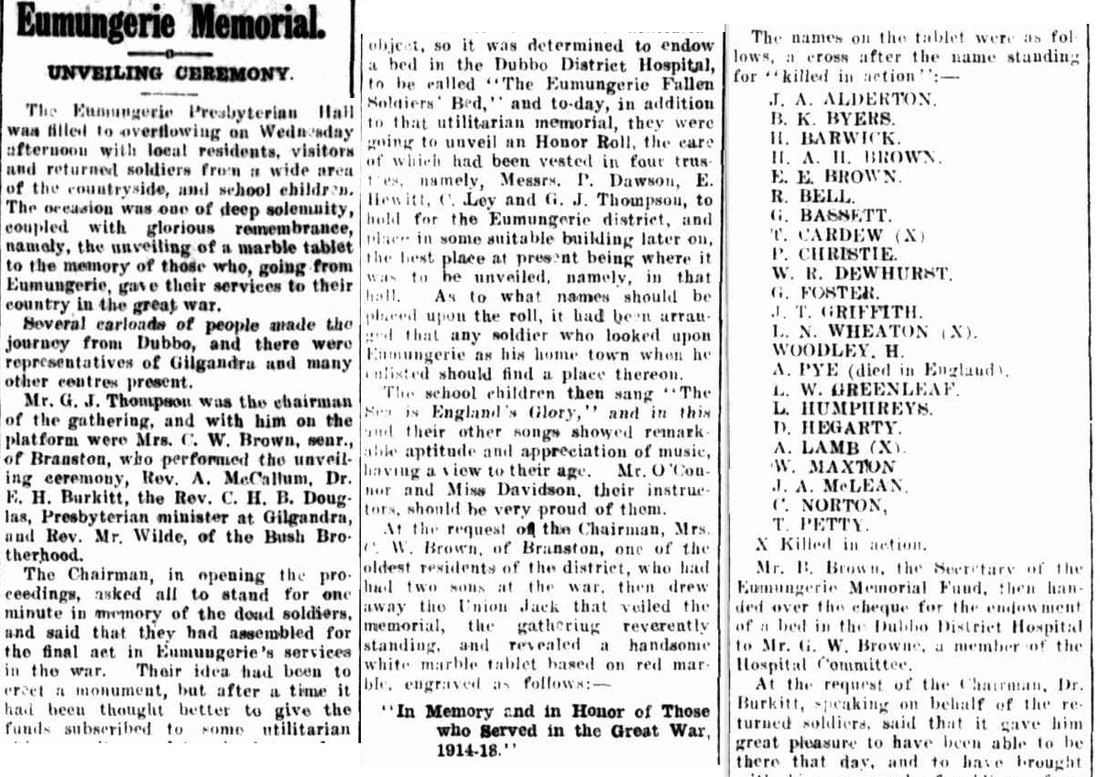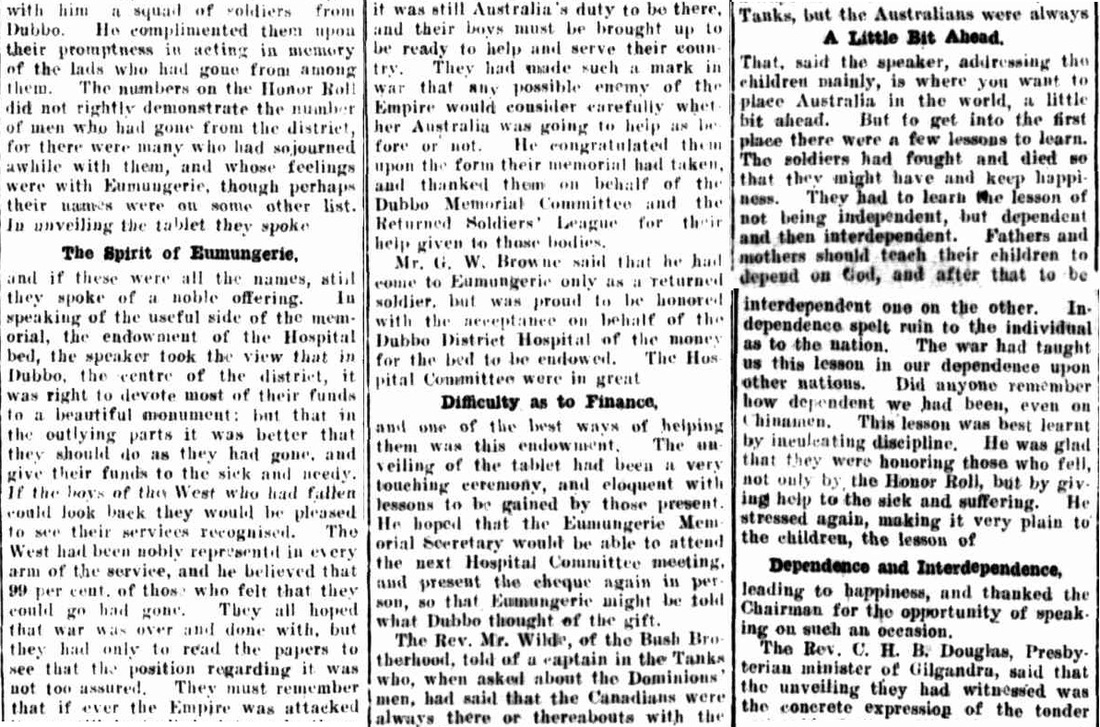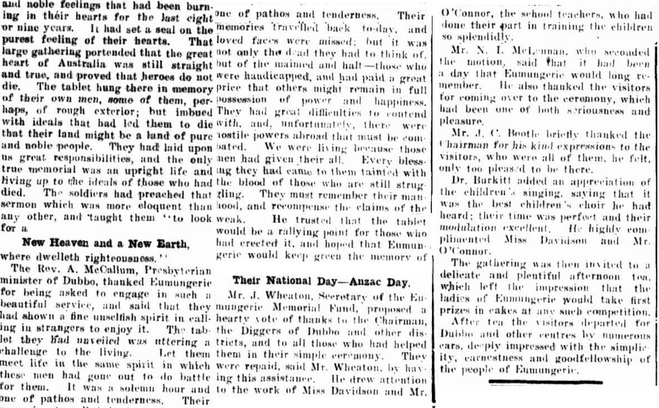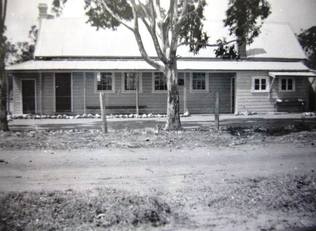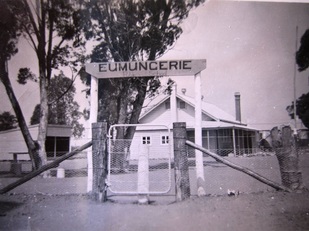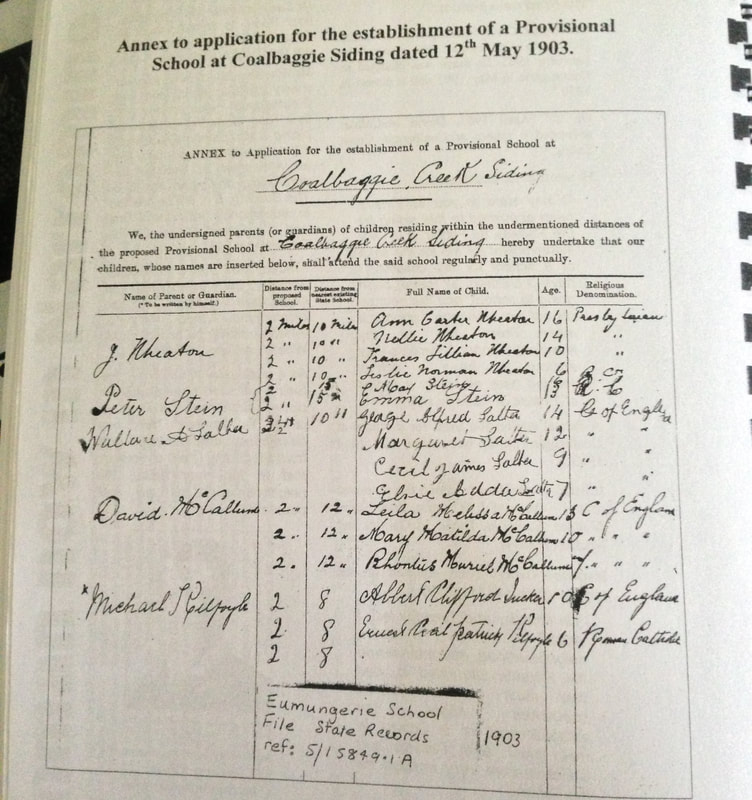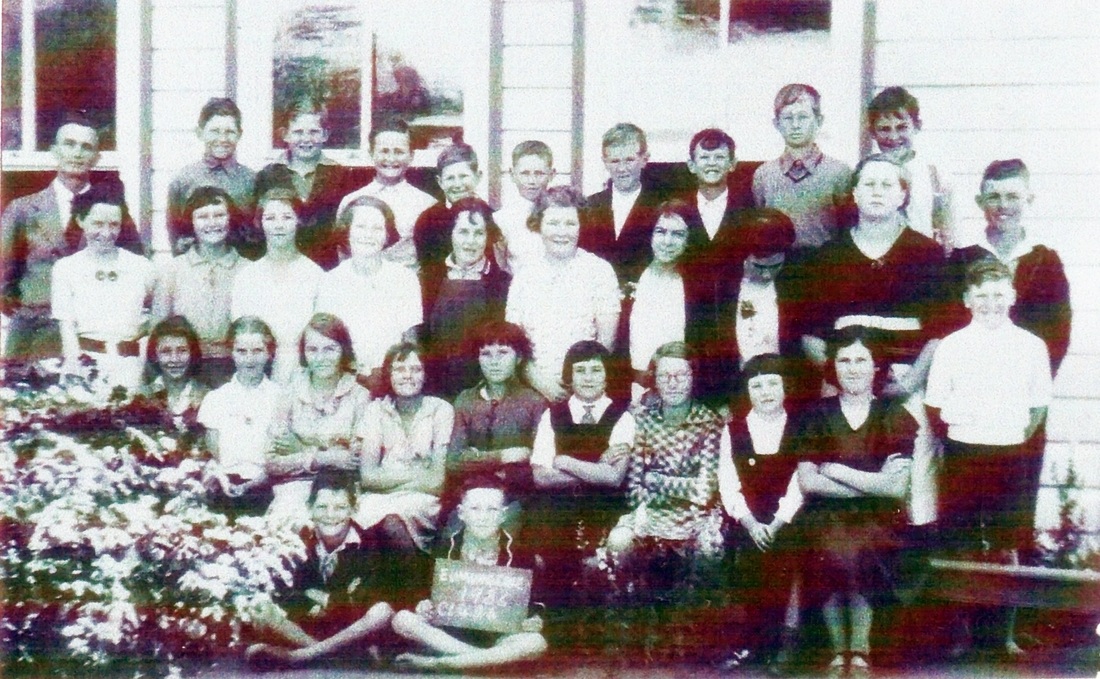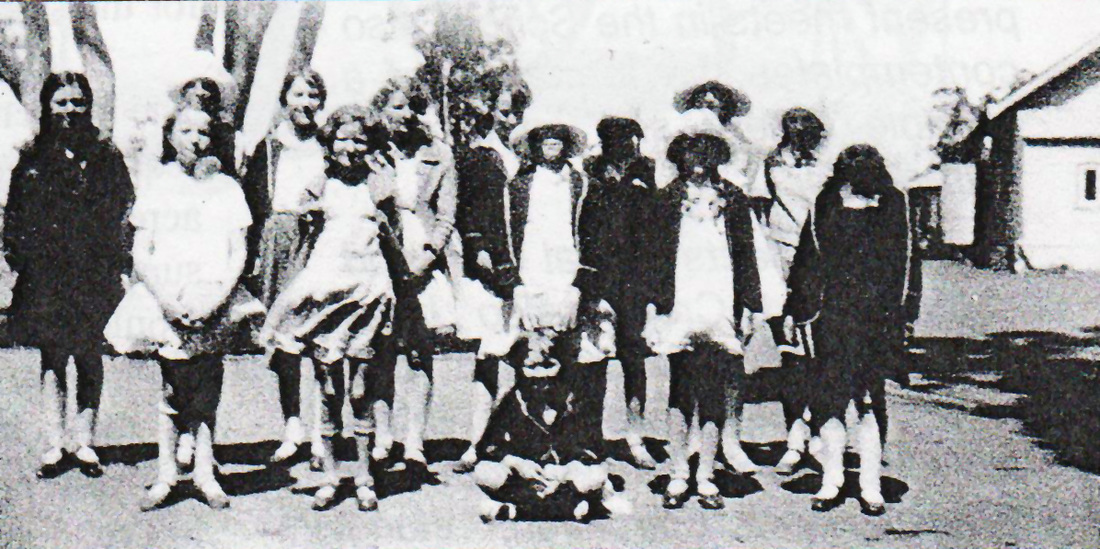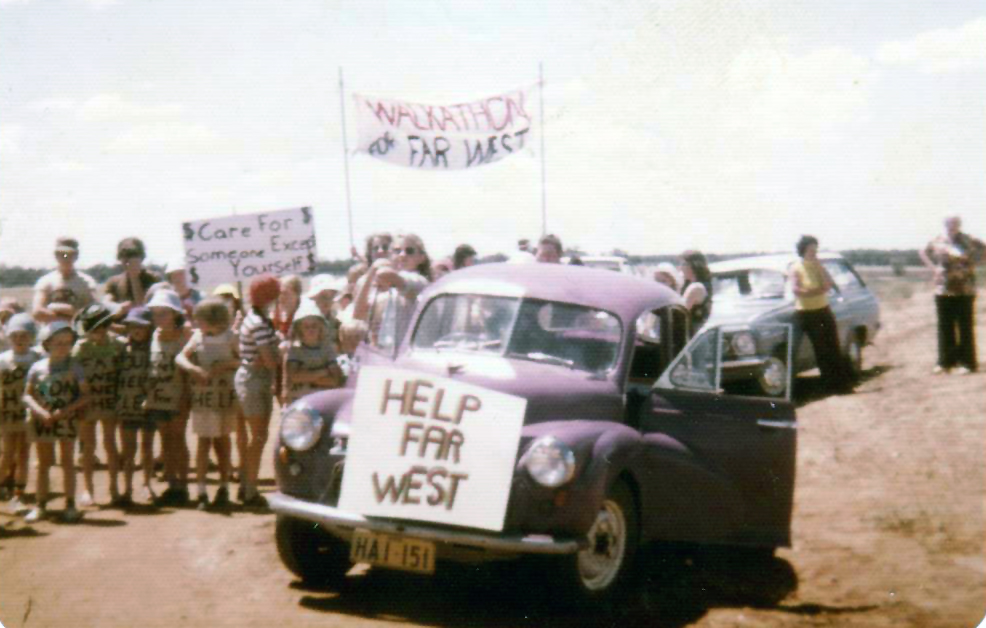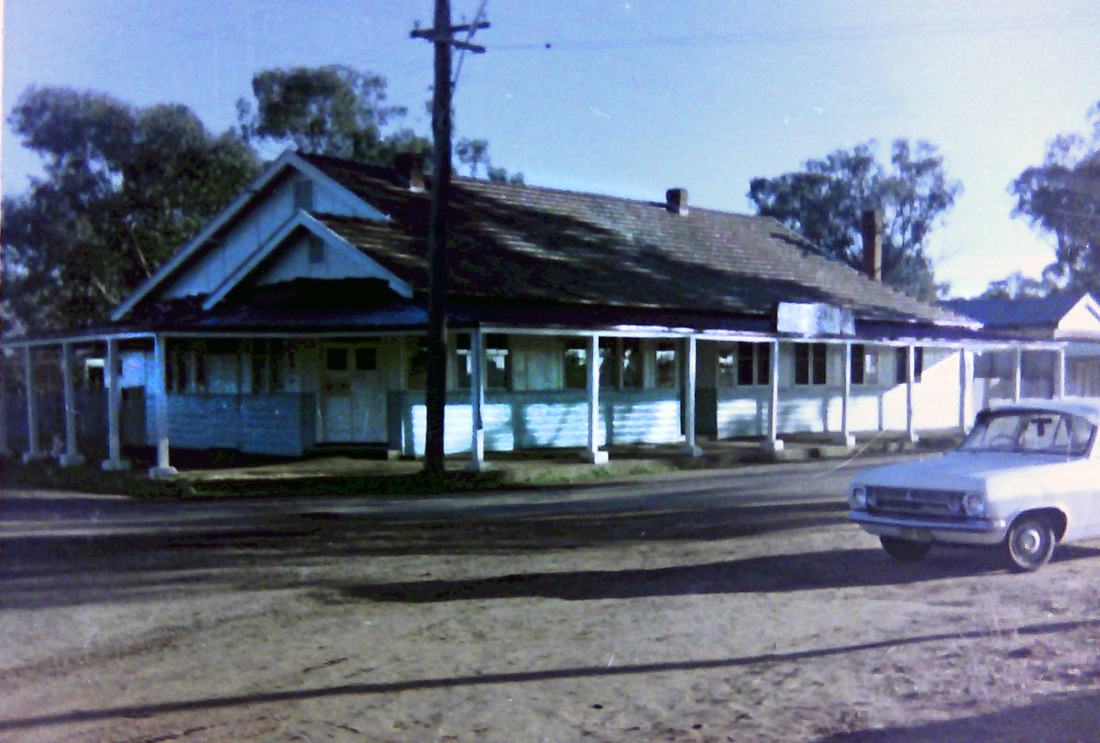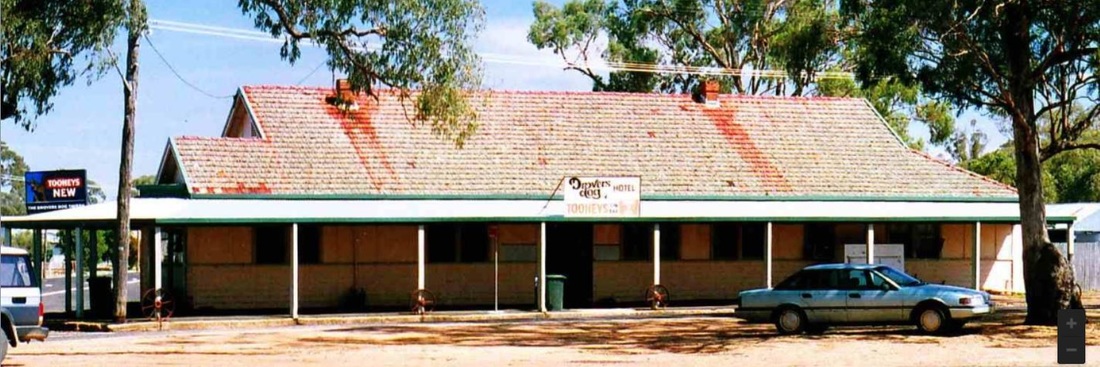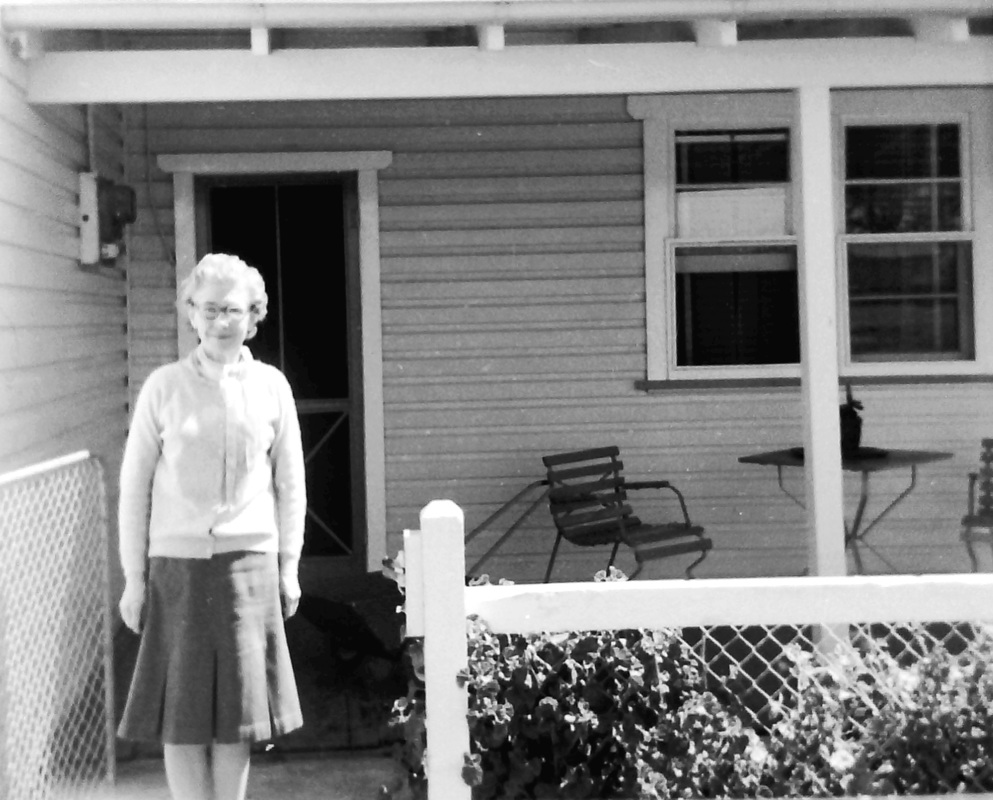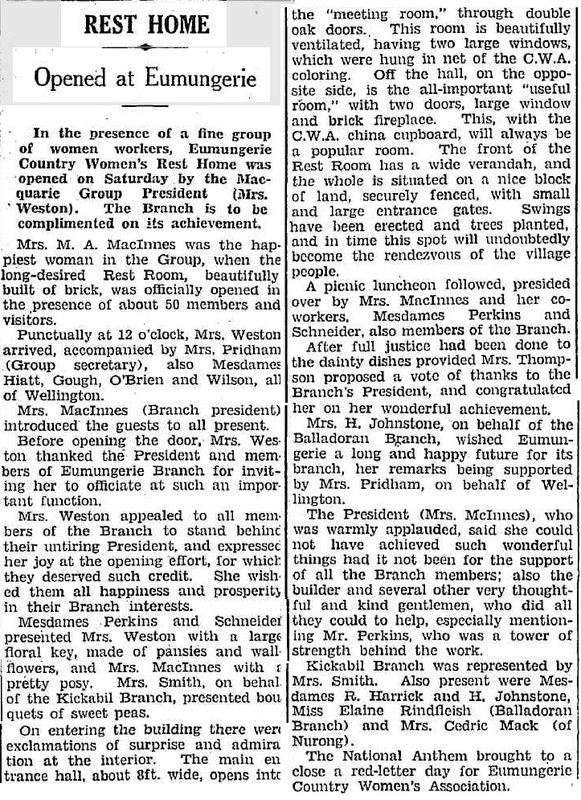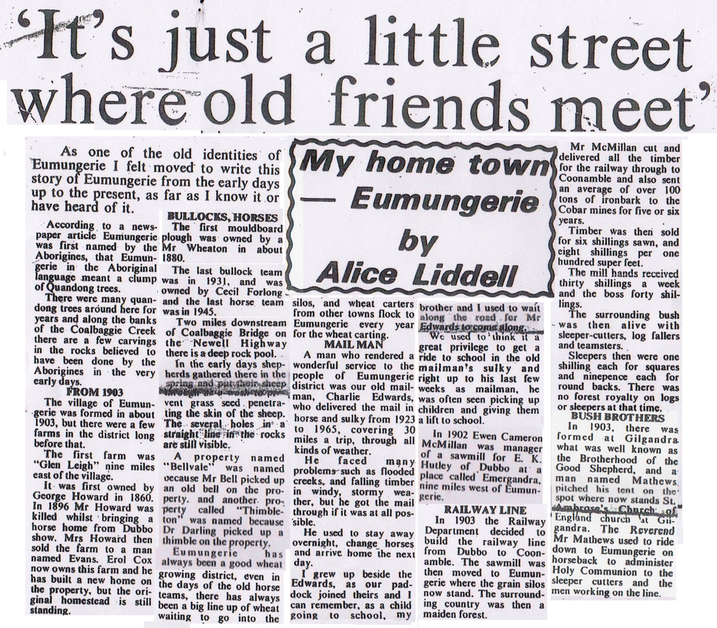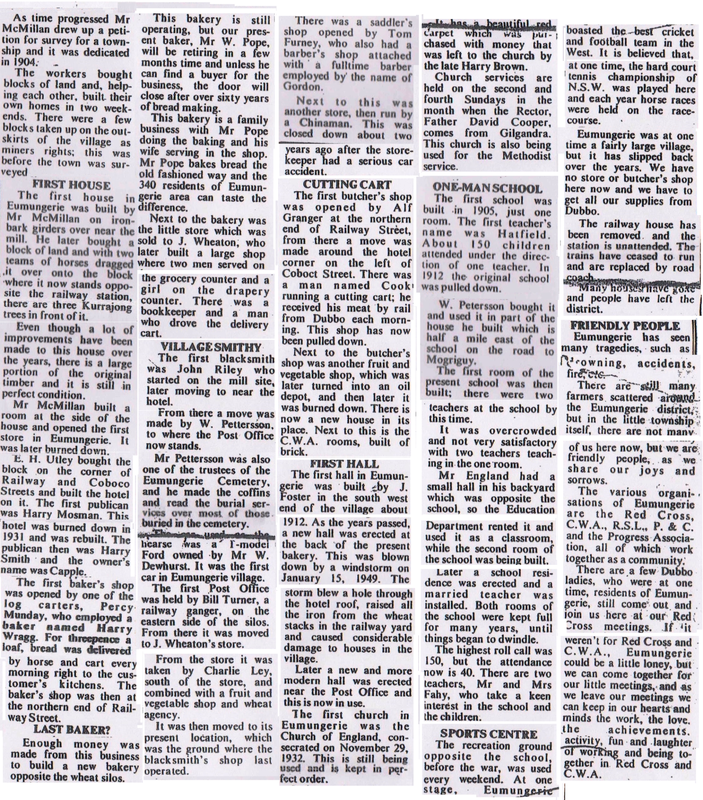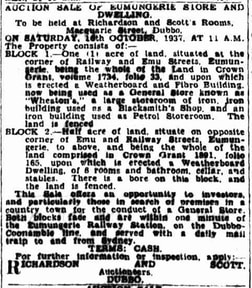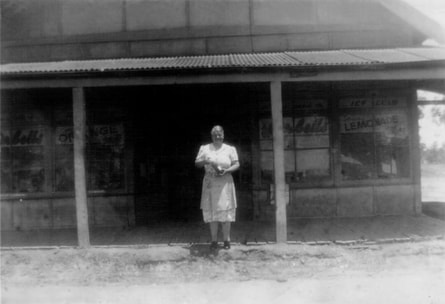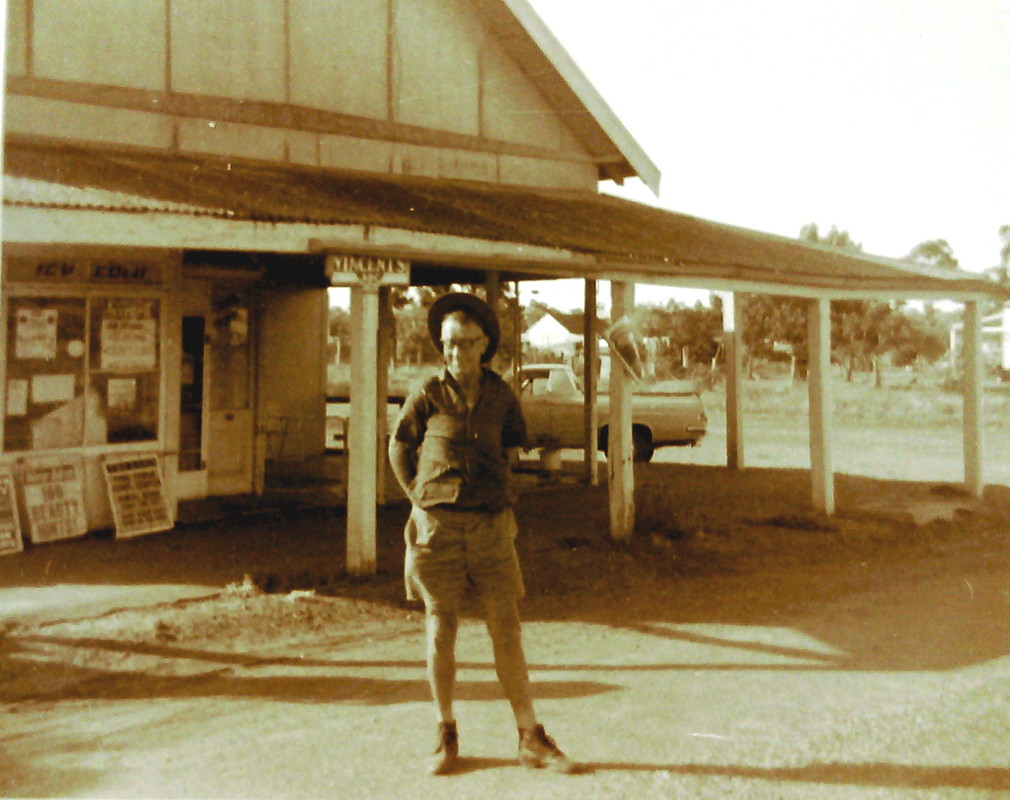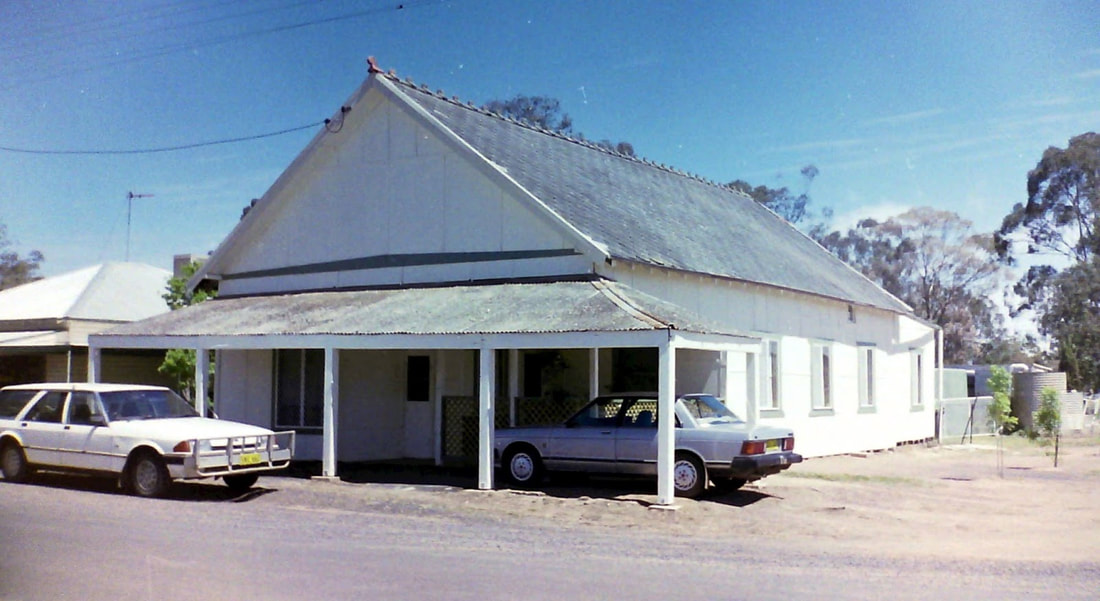Village History
|
CATALOGUE
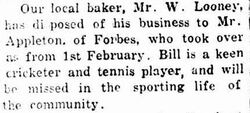
|
According to a published newspaper article, Eumungerie was first named by the Aborigines. Eumungerie in the Aboriginal Language meant a clump of quandong trees. There were many quandong trees around the area for many years and along the banks of the Coalbaggie Creeks are a few reported Aboriginal Carvings.
The village of Eumungerie was formed in 1903, but there were a few farms in the Eumungerie district long before that. The first farm was "Glen Leigh" which is situated nine miles east of the village, and was first owned by George Howard in 1860. In 1896 Mr. Howard was killed whilst bringing a horse home from Dubbo show. Mrs. Howard then sold the farm to a man named Evans. Errol Cox now owns this farm and he has built a new home on the property. The original homestead still stands today. The first Mouldboard plough was owned by a Mr. Wheaton in about 1880. The last bullock team was in 1931, and was owned by Cecil Forlong and the last operating horse team in 1945. Two miles downstream from the Coalbaggie Bridge on the Newell Highway there is a deep rock pool. In the early days shepherds gathered there in the spring and put their sheep through as a wash to prevent grass seed from penetrating in the skin of the sheep. The several holes in a straight line in the rocks are still visible. Eumungerie has traditionally been a good wheat growing district. Even in the days of the old horse teams, there has always been a big line up teams waiting to get into the silos. Wheat carters from other towns flock to Eumungerie every year ready for the wheat carting.
Charlie Edwards the old mailman has rendered an excellent mail delivery service to the farmers and people of the Eumungerie District between 1923 to 1965. The difference was that he would cover the thirty mile round trip in a horse and sulky, in all types of weather conditions. He faced many problems such as flooded creeks, and falling timber in windy, stormy weather, but he always got the mail through if it was at all possible. Mr Edwards would stay away overnight, change horses and arrive home the next day. I grew up beside the Edwards, as our paddock joined theirs. As a child I can remember by brother and I waiting along the road for Mr. Edwards to come along and take us to school. We used to consider it a great privilege to get a ride to school in the old mailman's sulky. Even up to his last few weeks as a mailman, he was often seen picking up children and giving them a lift to school. In the year 1902 Ewan McMillan was manager of a sawmill for E.K. Hutley of Dubbo at a place called Emergandra, nine miles west of Eumungerie. In 1903 the Railway Department decided to construct a railway line from Dubbo to Coonamble. The sawmill was then moved to Eumungerie where the grain silos now stand. The surrounding country was then a maiden forest. Mr McMillan cut and delivered all the timber for the Railway through to Coonamble. An average of over 100 tons of ironbark was sent to the Cobar Mines each year for a period of five to six years. Timber was then sold for around six to eight shillings per one hundred super feet of sawn timber. The mill hands received thirty shillings a week and the boss forty. The surrounding bush was then alive with sleeper-cutters, log fallers and teamsters. Sleepers then were one shilling each for squares and ninepence each for round backs. There was no forest royalty on logs or sleepers at that time. In the same year 1903, the Brotherhood of the Good Shepherd was formed at Gilgandra. Reverend Matthews pitched his tent on the spot where St. Ambros Church of England Church now stands in Gilgandra. Reverend Matthews would ride a horse down to Eumungerie to administer Holy Communion to the sleeper cutters and the men working on the line. As time progressed Mr. McMillan drew up a petition for survey for a township. The town was finally dedicated in 1904. The workers bought blocks of land and with the help of each other built their own homes in a couple of weekends. There were also a few blocks taken up on the outskirts of the village as miner's rights. This was however before the town was surveyed. The first house in Eumungerie was built by Mr. McMillan on ironbark girders over near the mill. Sometime later he bought a block of land and two teams of horses dragged it over onto the block where it now stands opposite the railway station. There are presently two Currajong trees growing in front of it. Even though a lot of improvements have been made to the house, a large proportion of it still consists of the original timber. Mr. McMillan built a room at the side of the house and opened the first store in Eumungerie. This store was later burnt down. E.H. Utley bought the block of land on the corner of Railway and Coboco Streets and built the hotel on it. The first publican was Harry Mosman. This hotel was burned down in 1931 and was rebuilt. The publican then was Harry Smith and the owner's name was Capple.
The first baker's shop was opened by one of the log carters, Percy Munday, who employed a baker named Harry Wragg. For threepence a loaf, bread was delivered by horse and cart every morning right to the customer's kitchens. The baker's shop was then at the northern end of Railway Street. Enough money was made from this business to build a new bakery opposite the wheat silos, and this bakery is still operating in first class condition in 1975. The present baker Mr. W. Pope will be retiring in about fifteen month's time. Unless a buyer can be found for the business it will be end of a sixty year tradition of bread making. The bakery is a family business with Mr. Pope doing the baking and his wife doing the serving in the shop. Mr. Pope always cooks the bread the old fashioned way with as little use of machinery as possible and the 340 residents of Eumungerie area can taste the difference. Mr. Pope came to Eumungerie and bought the bakery from a Mr. Jones 21 years ago. Next to the Bakery, going south, was a little store which was replaced by a larger General Store when purchased by Mr. J. Wheaton. The store employed two men in the grocery section, a girl in the drapery area, a bookkeeper and a man who operated the delivery cart. The first blacksmith was John Riley who started on the mill site, later moving to near the hotel. From there a move was made by W. Pettersson, to where the Post Office now stands. Mr. Pettersson was also one of the trustees of the Eumungerie Cemetery, and he made the coffins and read the burial services over most of the people buried there. The car used as the hearse was a T-model Ford owned by Mr. W. Dewhurst and was the first car in the Eumungerie Village. The first Post Office was held by Bill Turner, a railway ganger, on the eastern side of the silos. From there it was moved to J. Wheaton's Store. It was again relocated, being moved south to be combined with Charlie Ley's Fruit and Vegetable Shop and Wheat Agency. It was then moved to its present location, which was the block of land where Eumungerie's Last Blacksmith operated. Further south there was a saddlery owned by Tom Furney, who also had an attached barber shop. A full time barber named Gordon was employed.
Next to this on the southern side was another store run by a Chinaman. This store was closed down around 1973 on account of the storekeeper having a serious car accident. The first butcher's shop was opened by Alf Granger at the northern end of Railway Street; from there a move was made around the hotel corner on the left of Coboco Street. There was a man named Cook running a cutting cart. He obtained his meat by rail from Dubbo each morning. Next to the butcher's shop going west, was another fruit and vegetable shop, which was later turned into an oil depot. This was later burnt down. There is now a new house in its place. Next to this is the C.W.A. rooms built of brick. Further west was a chaff and grain store built by G.W. Woodley which was later sold and pulled down. Next to this on the Western Side was another fruit, vegetable and sweet shop which was later turned into a fuel depot. This has now been burnt down. The first hall in Eumungerie was built by J. Foster in the south west end of the village about 1912. As the years passed, a new hall was erected at the back of the present bakery. This hall was blown down by a windstorm on the 15th January, 1949. The same storm blew a hole in the railway roof, raised all the iron from the wheat stacks in the railway yard and caused considerable damage to houses in the village. Later a new and more modern hall was erected near the Post Office and this hall is now in use. The first church in Eumungerie was the Church of England. It is not known exactly when it was built, but it was consecrated on the 29th November, 1932. This church is still being used and kept in perfect order. It has beautiful red carpet which was purchased with the money that was left to the church by the late Harry Brown. The church service is being held on the 2nd and 4th Sundays in the month when the Rector, Father David Cooper travels from Gilgandra to conduct the service. He conducts the service at Coboco on the same day. This church is also being used for the Methodist service. The Catholic Church was constructed in 1924 at a cost £542.00 by Wallace & Wayne McGee. Eumungerie was at one time a fairly large village but its size has decreased over the years. We have no store or butcher's shop here now and we have to get all our supplies from Dubbo. The Railway House has been removed and the station unattended. On about the 15th September 1975 the trains will cease to run. This will be replaced by a road coach. We have at last a bridge over the creek leading into the town. Many houses have been burnt down, some have been pulled down.
Many people have left the district. Eumungerie has seen many tragedies, such as drowning, accidents, fire, etc. There are still many operational farms scattered around the Eumungerie District, however the village population has dropped markedly. The various organisations of Eumungerie are the Red Cross, C.W.A., R.S.L., P. & C. and the Progress Association, all of which work together as a community. A few of the Dubbo Ladies, ex-residents of Eumungerie still support the local Red Cross Meetings. If it wasn't for these organisations Eumungerie could be a little lonely. Eumungerie was at one time a fairly large village but its size has decreased over the years. We have no store or butcher's shop here now and we have to get all our supplies from Dubbo. The Railway House has been removed and the station unattended. On about the 15th September 1975 the trains will cease to run. This will be replaced by a road coach. We have at last a bridge over the creek leading into the town. Many houses have been burnt down, some have been pulled down. Many people have left the district. Eumungerie has seen many tragedies, such as drowning, accidents, fire, etc. There are still many operational farms scattered around the Eumungerie District, however the village population has dropped markedly. The various organisations of Eumungerie are the Red Cross, C.W.A., R.S.L., P. & C. and the Progress Association, all of which work together as a community. A few of the Dubbo Ladies, ex-residents of Eumungerie still support the local Red Cross Meetings. If it wasn't for these organisations Eumungerie could be a little lonely. This is a revised edition of an article written by Alice Liddell, a former resident, on the 5th September, 1975. Taken from the book Eumungerie School, Bicentennial Edition, 1988. Early Eumungerie
"I remember the first train that went through Eumungerie. I couldn’t have been very old at that stage but I remember coming in with my father in the dray to pick up some groceries dad had sent out on the train. Previously, we had to go to Dubbo to collect our groceries; flour, sugar, potatoes, onions. Dad used to buy everything in bulk but this time he had it sent out on the train, and I came in with dad on the dray and we stood on the platform, he and I, and as the train drivers went passed, we waved to them. They acknowledged our wave. We collected our potatoes and pumpkin and all that we had; put them up in the dray and away we started for home. Home was Mountain View, and then the time came to unload. Mother had a big box; a great big box in the pantry that she used to put the flour in and sugar; to keep it mouse proof, to keep all that away from the mice. Well we unloaded when we bought it home and put it in this great big box. Source: Memoirs of Margaret Lesslie (nee Salter) 1983
Eumungerie Memorial Unveiling Ceremony 1923
Eumungerie Public SchoolAn application for the establishment of a provisional school at Eumungerie, (originally known as Coalbaggie Creek Siding), was made in 1903.
Both parents and children were anxious for the school to be established as the nearest school was twelve miles away. At that time, Mr Wheaton's children were being taught at home by one of his daughters, whilst Mr Salter's children were living away from home so they could attend school at Brocklehurst. The remaining children did not receive any schooling. The first school was built in 1904, following a number of delays. It comprised a single classroom and two out houses. The builder was a Mr Clark, who earned 79 pound for his work. It was originally recommended on the 14th May 1903 that a Mr. J. Wheaton construct the Coalbaggie Siding School for an allowance of 45 pound. Unfortunately the site wasn't dedicated until the 29th October 1903 and by this time Mr J. Wheaton was too busy with harvest. Finally on the 20th February 1904, a Government Gazette notified the reservation for Public School Purposes of an area of 8 acres in Parish of Eumungerie, County of Ewenmer. New tenders were offered and Mr Enoch Clark of Trangie his tender was accepted on 25th March 1904. Oh the 16th July 1904 to avoid confusion with the nearby Provisional School Coalbaggie Creek a new name was adopted from the adjoining railway siding Eumungerie. On 30th April 1903, David McCallum requested a school at Coalbaggie Creek Siding. He wrote to the Department: "I may state to you as I have been appointed to this siding by the Railway as Fettler, it is very inconvenient for me for the sake of a school for my children. I have three children, all (have) been going to school; and the nearest school is Goonoo about nine miles.... There are to my knowledge about five families very anxious to have a school erected here all within a radius of two miles of Railway siding". A formal application form for a school at Coalbaggie Creek was dated 12th May 1903. It listed 15 children to attend the proposed school — those of J. Wheaton, Peter Stein, Wallace A. Salter, David McCallum and Michael Filfoyle. Inspector George Hunt reported on the application on 14th May 1903: "On Monday and Tuesday last, I visited the above neighbourhood, and interviewed the Parents interested in, and saw most of the children concerned about, the establishment of a School in their midst. Both Parents and Children were very anxious for the School. At present Mr Wheaton's children are being taught at Home, by one of his daughters. Mr Salter's family are living away from Home to attend School at Brocklehurst. The other children are receiving no schooling. Mr Wheaton has offered to erect a very suitable School room and 2 outhouses — also provide and fix a Tank, Guttering — and down piping — also paint the Buildings, if the Department will make him an allowance of E45 for the purchasing of timber, iron & c. The Building, & c, will be erected in accordance with the Plans and Specifications the Department may submit. I recommend that a Provisional School be established at Coalbaggie Siding, I also recommend that Mr J. Wheaton's offer be accepted, Mr Wheaton is very reliable. As a good deal of land near the Siding will soon be available for closer settlement, and as a larger Government Tank has been constructed about 1/2 mile from the Siding, I am of opinion, that in the near future, the neighbourhood will be well populated". The first teacher was a Mr Arthur Hatfield appointed in August 1904 to Eumungerie Siding Provisional School with an enrolment of 22. His monthly wage was reported as being 7 pound, six shillings and eight pence. Mr Edward O'Halloran had unfavourable inspection reports while at Eumungerie. One of the criticisms was the lack of a school garden. In September 1910 he wrote of this deficiency: "There is no garden at present, but a garden plot was formed at the rear of the school a few months ago, but the goats of the neighbourhood (there are a great many) soon devastated it of its cheerful aspect. In fact these animals have taken a particular fancy for the green picking around the school and they make it a regular camping place. One dare not approach the parents with the hope that they would keep the goats away, for the goat is to these poor people what the horse and cow are to their more wealthy neighbours". On 14th November 1911 H. Masman, secretary of the Eumungerie Progress Association, wrote to the local Member of Parliament that: "That there is grave necessity for more accommodation, as under present conditions it is very overcrowded, some of the children having to be seated on the floor to do their lessons, and the building itself is in a deplorable conditions". Edward O'Halloran resigned in April 1911, writing that this was: "partly owing to health and partly owing to the attitude taken by the Department re the inspector's report (which indicate) that it would not be advisable for me to remain in the service any longer". EUMUNGERIE PUBLIC SCHOOL, 1915
Back Row: A. England, R. Ward, D. Ley, C. Fisher, G. Burrows, J. Dohnt, A. Alderton, J. Wakefield, L. Foster. 2nd Row: Ollie Munday, E. Smith, L Fisher, F. England, G. England, unknown, unknown, L. Foster. 3rd Row: Audrey Smith, E. Smith, E. Wakefield, E. Ward, J. Nagle, K. Smith, G. Vandermaal, R. Buck, N. Ward. 4th Row: N. Woodley, D. Dickerson, A. Burrows, M. Barwick, M. Ley, M. Owen, M. Dohnt, - Merton, - Merton, B. Hewitt, J. Wheaton, E. Wheaton. Front Row: W. Fisher, A. Ward, F. Dohnt, - Jarvis, K. Buck, D. Petterson, F. Buck. A number of locals have indicated that at times enrollments have reached about 150. The difference which exists between the departmental records & what is generally stated may be the result of itinerant workers such as timber cutters, fettlers, etc. moving in & out of the district or the gaps in the available departmental records.
In January 1908 the school was raised to public school status. In 1912 the original school was pulled down. W. Pettersson bought this school and used it in part of the house he built which is situated half a mile east of the school on the right hand side of the road going towards Mogriguy. By this time, two teachers were employed at the school. As they both taught in the same classroom, conditions were considerably overcrowded. The first classroom of the present school building was then constructed. Mr England had a small hall in his backyard which was opposite the school, so the Department of Public Instruction (now known as the Department of Education), rented this hall & used it as a classroom, whilst the second room of the school was being built. Both rooms of the school were kept full for many years, until the population began to dwindle. Written by Trevor Sawtell from the book Eumungerie School, Bicentennial Edition, 1988. Eumungerie School, Centenary Book 1904-2004, p.27, 29 EUMUNGERIE PUBLIC SCHOOL, 1936
Back Row: Mr Whiteby (teacher), Roy Vandermaal, Brian Wheaton, Keith Barwick Coleman, Ron Mason, Max Keir, Doug Barwick, Eddie Cleaver, Albert Barwick. 2nd Row: Miss Cawley (teacher), Doris Vandermaal, Doris Lesslie, Smith, Elaine Coleman, Joyce Edwards, Joyce Schneider, Nancy Norris, Norman Sharp. 3rd Row: Jean Leach, Jean Petterson, Joyce Sharp, Jean Barwick, Triplett, Ella Griffith, Ruth Tomlinson, Alice Griffith, Dulcie Finch. Front Row: Ray Edwards, Milton Perkins. 1988 Bicentennial Book error - Nancy Morris should be Nancy Norris, corrected by Doris Nagel (nee Lesslie)
EUMUNGERIE PUBLIC SCHOOL 1932
Back Row: Marg ?, J Croaker, Una Buck, Jean Darling, Margaret Vearing, Miriam Triplett, Leila Norris, Una Foster Front Row: Dulcie Lesslie, Lorna Darling, Betty McGrath, Joyce Barwick, Alice McGinnes Sitting: Jean McGrath 1988 Bicentennial Book error - Leila Lesslie should be Leila Norris, correction by Doris Nagel (nee Lesslie) Eumungerie HotelThe earliest reference to a hotel was in 1872. A Mr Thomas Foran kept a wayside inn, small store and resting paddocks. It was located near the junction of Drilwarrina and Coalbaggie Creeks next to the main route to Coonamble. The existing Eumungerie Village is located north of the small Coalbaggie Creek Settlement which developed around the hotel. The Coalbaggie Hotel was referred to in communications between Postal Inspector Burnett and the Dubbo Postmaster on the 1st Sept, 1891 in discussion concerning the establishment of a Receiving Office at the Coalbaggie Hotel. This proposal was rejected. The commencement of the railway link from Dubbo to Coonamble on the 15th November 1900 was a catalyst which finally resulted in the development of the Eumungerie Village in its present location.
"In the year 1902, Ewen Cameron McMillan was a manager of a sawmill for E.H. Utley of Dubbo at a place called Emergandra nine miles west of Eumungerie (1)". This sawmill was relocated to a spot beside the railway track. This development became the nucleus of Eumungerie Village. The surrounding areas were a source of good iron bark timber. Mill owner, Mr E.H. Utley purchased a block of land on the corner of Railway and Coboco Streets & built a hotel on it.
The first publican was Harry Mosman. According to the locals the front portion of the hotel was of Pizzy Construction (mud). Mr. William Robert Fisher moved from "Glenwood", Dubbo on Friday 25th September, 1912 to take over as publican of the Caledonian Hotel, Eumungerie. He later changed the name to the Eumungerie Hotel. His three daughters Gladys, Ethol and Madge attended the local school. In 1930 Eumungerie Football Club presented the publican Mr Smith with a photograph of the Eumungerie Premiership Football Team. This now hangs proudly in a prominent part of the hotel. In 1931, the hotel which was then owned by a Mr Capple was burnt down and then rebuilt. On the 15th January 1949, Eumungerie Hotel was damaged by a windstorm. Pat & John Hay took over as publicans of the Eumungerie hotel on the 18th May 1981. In 1981 the hotel underwent extensive renovations with improvements to the beer garden the bar area being completely remodelled in a colonial styling. They renamed the hotel the Drovers Dog Tavern Hotel. Today the Drovers Dog Tavern patrons are Bev & Bill Ross. The hotel has a historical bush character all its own. It is equipped with a bar & a ladies lounge adorned with historical per cutting and farm implements, etc. It has two game rooms, five guest bedrooms and a beer garden with barbecue facilities. The hotel is utilised by clubs, locals, farmers, truck drivers, and tourists. The hotel is utilised by clubs, locals, farmers, truck livers, and tourists. One of the locals tells a story of how some of the local railway workers (fettlers) would at night sneak over to the trucks laden with wooden barrels of beer. They'd drill bole into the barrels and syphon out the beer into their containers. They would later plug the hole and leave one none the wiser. Written by Trevor Sawtell from the book Eumungerie School, Bicentennial Edition, 1988. (1). E T McMilan, History of Eumungerie, School Copy, March 1969, p.1.
Eumungerie Post OfficeThe history of the beginning of a Postal Service goes back to the time when the area was known as Coalbaggie, later to be called Eumungerie.
The first reference in postal records in April 1874 was a mention of a mail service delivered by a mail contractor named Joseph Hull of Talbragar. Deliveries were made twice weekly and he was paid the large sum of eighty pounds per annum. The following year Cobb & Co took over the deliveries. The first application for a receiving office to be established in the area was made by a Mr Thompson the local hotelier in 1891. A petition was again tendered by the residents of the district in 1893 calling for the establishment of a Receiving Office. Records show this petition was successful indicating that the Receiving Office commenced on 9th February, 1983 under the care of a Mr Frederick Smith. Mr Smith resigned on the 9th of November the same year & with no successor the office was closed. In a later petition a receiving office was again opened this time at the railway station under the care of Mrs Emily Brady on the 15th September 1902. Her allowance was the small sum of five pounds per annum. Miss Elizabeth Wheaton followed Mrs Brady into office on the 18th February, 1903. On the 7th July 1903 a request was made that the siding name should be known as Eumungerie & not Coalbaggie to save confusion. Permission was duly granted on the 8th July 1903. In April 1904 residents requested a Post Office but were refused, and the Receiving Office was placed in the charge of Mrs Elizabeth Mc Callum who lived closer to the platform on the 16th May 1904. Miss Wheaton's office was closed. Mrs. Adelaide Turner succeeded Mrs. McCallum on the 28th March, 1906 and five pounds paid to the Railway Department for a postal allowance. On the 11th July, 1907 a request was made by Mr. H. Machin the Hon. Sec. of the Balladoran Farmers & Settlers that the Receiving Office be converted to a P.O. for the sale of stamps, postal notes, and registration of letters. The Receiving Office was converted to a P.O. on 10-9-07 and an advance in stamps to the value of three pounds and postal notes to the value of seven pound, nine shillings and seven pence. The Railway Telephone was made available for public business on the 1st April, 1908 on the condition the Railway Department received half the revenue. The railway telephone system enabled Eumungerie to be in contact with Dubbo, Gilgandra Balladoran, Goonoo and Curban. A request was made on the 19th November, 1908 from the Railway Department for an increase in yearly pay to twenty five pounds p.a. as business had increased considerably. A recommendation was made on 10 January 1909 that the increase be allowed. The yearly return for 1908 showed Revenue income of a total of sixty eight pounds and expenditure of ten pounds. 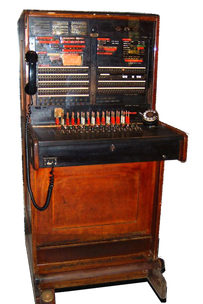 PBX Telephone Switchboard PBX Telephone Switchboard
A Mr Masman the Secretary of the Progress Association wrote in March 1912 that the present P.O. was not in a convenient position and requested the erection of a new building. The request was denied as the annual revenue at this stage was only one hundred and twenty four pounds. Mr. Wheaton resigned in September 1912 and nominated Mr. W. Doyle a Railway Officer to replace him & recommended business be conducted at the railway station. The Railway Department refused so Mr. Wheaton agreed to continue until an official office was built on the condition his allowance be increased to fifty two pounds p.a. Mr. Wheaton's offer was ultimately accepted.
Mails arrived daily six days a week, arriving from Sydney at 9.30 a.m. & returning from Coonamble at 4.50 p.m. Mr. Wheaton resigned and Mr. Charles Ley was appointed on the 8th July, 1913. Mr. Ley had a fruit & confectionery business about ten yards down the street, now known as Railway Street. The telephone exchange was opened in July, 1914. The first subscribers were listed as follows in the August 1914 Telephone Directory.
Money Orders were made available in November, 1914 and about the same time the Commonwealth Bank was opened.
Mr. Ley was still P.M. in December 1926 when he applied for his allowance to be increased to twenty six pounds p.a. This was granted being his first increase in 12 years. Mr Ley, used a horse and sulky to convey the mail to and from the railway. Mrs. Ley was appointed temporary Postmistress on the 1st March, 1934 whilst Mr. Ley was ill; she remained as Postmistress after Mr. Ley's death in April, 1934. She resigned in 1934 owing to failing health. Mr J. Oliver rented the Post Office portion of the premises when he succeeded Mrs. Ley. He remained there until the new premises being erected by Mr. J.T. Griffith of "Mountain View", Eumungerie became available for rent. The present building took three months to build and was by a building contractor Mr. N. Foxall. The building originally occupied in May 1943. Written by Faye Brookfield from the book Eumungerie School, Bicentennial Edition, 1988.
Country Women's Association |
Wheaton's Store
Disclaimer |
Report Something Broken
© 2013 - Suzanne Nagel historicalfamilies.com

